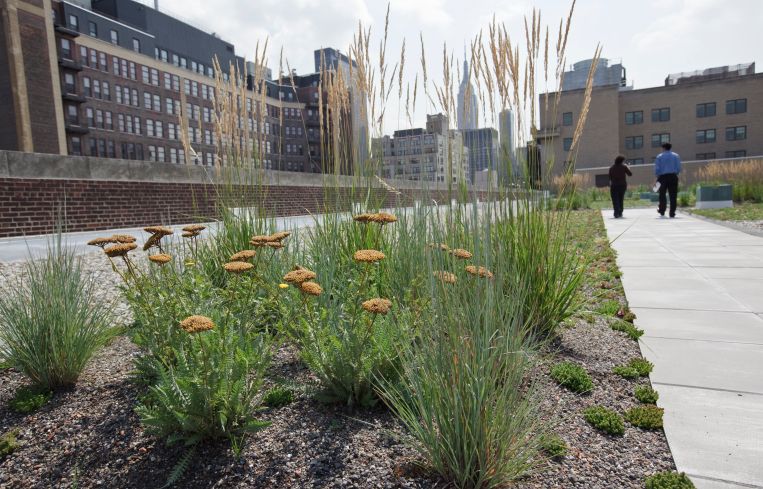How to Reduce Your Carbon Footprint Without Reducing Your Office Footprint
By Petra Durnin May 25, 2022 6:06 am
reprints
According to the recent Office Pulse Survey from digital media company Captivate, 59 percent of professionals in the U.S. and Canada say their offices have made environmentally friendly changes in the last three years.
The report found 65 percent of offices are providing recycling bins, 40 percent are shutting off lights and electronics when not in use, and 24 percent are eliminating disposable cutlery, plates and bowls.
The sustainable office of today requires more than just green initiatives that involve the standard reduce, reuse and recycle campaign. While these efforts are commendable, employees at these offices don’t believe their companies are doing enough, according to the report. Although 54 percent said their companies consider themselves “green,” just 40 percent of workers actually consider their companies to be environmentally friendly.

More and more employees want to work in sustainable offices, and reducing workers’ carbon footprint can also be beneficial to a company’s bottom line. Additionally, clients are asking companies what their sustainability practices are with greater frequency. There are meaningful steps companies can take at the building and operational levels to make real changes. Sustainability is a product of the efforts of an entire organization.
Benefits
According to a 2021 NEXT Energy Technologies report, 37 percent of respondents said a lack of natural light in the office negatively impacted their health. The report also indicated that 80 percent of managers said they would improve their office’s sustainability to retain employees.
Employing sustainable elements like natural light have proven benefits. According to the Human Spaces Report, employees who work in environments with natural elements report a 15 percent higher level of wellbeing, are 6 percent more productive, and 15 percent more creative overall.
When it comes to a company’s bottom line, going green can be beneficial as well. Replace incandescent bulbs with compact fluorescent bulbs (CFLs), which use up to 75 percent less energy and can last 10 times longer.
Building
One of the best ways to create a sustainable office is by building, or leasing space in, a green-certified office building. LEED-certified buildings save money, improve efficiency, lower carbon emissions and create healthier work environments. They are designed to address carbon, energy, water, waste, transportation, materials, health and indoor environmental quality.
According to the U.S. Green Building Council, LEED-certified buildings contribute 50 percent fewer greenhouse gasses (GHGs) than conventionally constructed buildings due to less water consumption, 48 percent fewer GHGs due to less solid waste, and 5 percent fewer GHGs due to a reduction in the number of single-occupant vehicles traveling to a building daily.
Though these buildings have sustainability baked into them, there are additional changes companies can make to existing structures to make them more sustainable. Green roofs can be built on top of virtually any structure. A green roof system — comprising layers of vegetation, filters, drainage and structural support — not only improves the aesthetics of a building but is also cost-effective. These living roofs help regulate building temperatures, manage stormwater runoff and naturally filter excess water to reduce pollutants.
Operations
Beyond large-scale changes at the building level, companies can make a number of operational changes. Enhancements include implementing new technology like solar-powered lighting, smart glass and sensors to collect and exchange environmental data.
Companies could also consider integrating elements of biophilic design, which incorporates nature or natural elements such as daylighting, natural ventilation, living walls, and water features such as fountains or ponds. These elements reflect the natural world and improve the health and well-being of employees.
In addition to these physical changes, companies should also consider green initiatives that incentivize more sustainable behavior among employees. Incentives for reducing carbon emissions during daily commutes could be supported by providing reimbursement for public transportation or bike-share programs.
Additionally, though work-from-home programs have become more popular due to the pandemic, they have environmental benefits as well. Spain’s Institut de Ciència i Tecnologia Ambientals report suggests that working from home four days a week would reduce global traffic emissions by about 10 percent.
Even if these steps seem dramatic or unachievable, there are still small ways to reduce carbon footprints that are completely within reach. Simply raising the temperature of air conditioning a couple of degrees has an overall impact on costs and the environment. Companies can invite employees to not only champion sustainable causes but also brainstorm solutions and hold each other accountable. Make it fun! Contests are a great way to get employees to participate in sustainability initiatives. Choose one small practice such as turning off lights when no one is in a room, and after a few weeks add another such as cutting back on paper use.
Starting simply ensures overall success and participation and can add up to big impacts.
Petra Durnin is the head of market analytics at Raise Commercial Real Estate.


